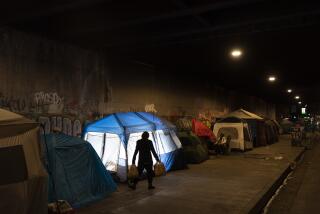Wandering Among the Lost Souls
- Share via
As Greyhound bus terminal manager Rolando Cracamo remembers it, the man arrived at the depot, just east of skid row, around 8 p.m. Friday.
He assumed it was James Riggs, a vagrant who lived on the streets of Jacksonville, Fla., and had been given a one-way ticket to Los Angeles by his hometown cops. He had not been convicted of anything, but considering the crime-ridden state of his destination, he might have been safer in prison.
Cracamo didn’t talk to the man. In fact, he couldn’t say for sure that it was James Riggs. But Cracamo said he looked like the person described in a Times story about Riggs’ journey--an amiable, bearded man with bad legs and a shaky hold on reality. A television crew interviewed the passenger, Cracamo said, and then the man dropped from sight.
Out of sight, into L.A.’s grimy back door, skid row.
*
Curious about what awaited this stranger on our skid row, I visited the area three times in the last few days, exploring the place where the poor arrive, one of the most despairing parts of the city we like to describe as “world class.”
Nobody knows the route the traveler took from the Greyhound station, but Liz Moorhead, director of communications for skid row’s Union Rescue Mission, said it would be fairly predictable. He’d head west from the bus terminal, which is on 7th Street, east of Alameda Street. He’d be drawn, she said, by the bright lights and tall towers of downtown.
Tuesday, Times photographer Bob Carey and I drove to the station, parked, and began walking west on 7th Street.
Across the street, at an abandoned Bank of America branch, a derelict, one foot shoeless, slept in a street camp made of cardboard boxes. A slender young woman, surprisingly well turned out in a T-shirt and tight workout pants, snoozed on the sidewalk a few feet away.
From here we could see downtown and pick out the tower of the Biltmore Hotel. I thought of the elegant lobby in the tower, and the Biltmore’s bars and restaurants. Talk about being so near and yet so far.
Instead, we stopped at a sign nailed to a telephone pole advertising the Terminal Hotel, 1331 E. 7th St., $11 a night, single occupancy.
We walked to the hotel. A large red and white sign warned “No Trespassing.” The door was protected by bars as thick as you’d find in a good jail. But it was unlocked. I pushed it open and we walked up a dark flight of stairs.
The “front desk” was a small window. Another barred door separated the rooms from the lobby. Carey began taking pictures. The manager quickly concluded the phone call he was making and said he would be very angry if Carey continued his shooting.
We thanked him and left. We walked past the produce market, a prosperous island of commerce amid the gloom. Mostly, there are small markets and tiny, dark restaurants. The smell of grease and urine was in the hot, smoggy midmorning air.
Carey shot the street scene. A man saw him and started screaming at us. His message was “No pictures,” laced with a torrent of profanity.
We stopped at another hotel, the Ford. On a previous trip, I had been attracted by its sign: “The Good Old Days Are Back, $11 a night.” A man was nailing bright green advertisements on the hotel wall. He asked us not to take his picture. He said he didn’t want people to see it in the paper and discover where to find him.
Another man, spying the camera, covered his face with his jacket as he walked into the hotel. I could see why the Ford’s guests might want to guard their privacy. Two police detectives, coats off and guns visible, entered the Ford, obviously not on a goodwill mission.
On the way back to the bus station, the man who had cursed us earlier now stopped to apologize.
He said it was the drink talking, not him. He blew up, he said, because he didn’t want his picture taken. He didn’t want anyone to know he was here.
*
Possibly our traveler made it up 7th Street to Towne or San Julian streets, where, at that time of night, there are several homeless encampments.
Possibly someone directed him to the Union Rescue Mission, with its 300-plus beds and 300-plus chairs where the homeless wanderer can find a space until breakfast.
It’s the only mission open 24 hours a day and the one where our traveler would most likely go. I asked the mission’s Liz Moorhead if he had shown up Friday night, but she couldn’t say. The mission keeps the names of its guests confidential. Besides, she said, most don’t give their real names.
That made sense. Few admit they live on skid row. Its residents, many of whom are battling mental illness, drug addiction and alcoholism, just want to disappear.
We like it that way, too. Segregate them on skid row and forget them.
I couldn’t find James Riggs. A CNN crew had met him at the Greyhound station Friday night, but he said he didn’t want to be interviewed on camera. He was too shy. And so he disappeared into the night, after saying he was going to find a mission.
Maybe Riggs found himself a safe harbor for the night. Maybe he has survived the dangers of skid row. I hope so. But whatever happened to this traveler, he has performed a service by reminding us of the misery that exists at L.A.’s back door.
More to Read
Sign up for The Wild
We’ll help you find the best places to hike, bike and run, as well as the perfect silent spots for meditation and yoga.
You may occasionally receive promotional content from the Los Angeles Times.






